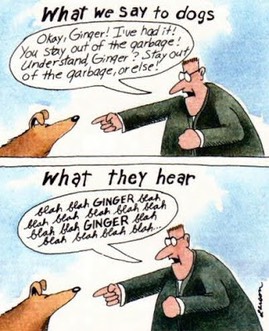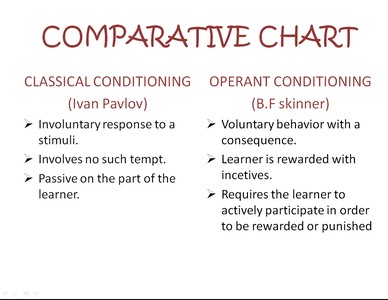
There is an old Russian proverb, Doveryai, no proveryai. It became more well known in the English axiom, “ trust but verify” when adopted by President Ronald Regan describing his work with American Soviet relations. It is a valuable principle in many aspects of life but is especially beneficial when dealing with training philosophies and concepts.
Recently I was browsing the internet regarding dog training as I am wont to do, attempting to keep up with the latest. I watched a video of a trainer discussing pack mentality of dogs, the importance of getting the respect of your dog when dealing with fear aggression and how to give proper corrections in order to achieve compliance. It was entertaining to watch.
The trainer had charisma. He sounded as if he knew what he was talking about or at least, his statements were emphatic enough. He backed up his discussion demonstrating with an apparently fear reactive dog walking past another dog showing a before and after video clip.
It was convincing as could be evidenced by the comments of support made by followers on his videos. Or it was convincing if one did not look deeper than face value.
Unfortunately, it was also fluff

You have heard me discuss the concepts of classical and operant conditioning in other blogs. I have also explained the psychology of fear and the dangers of using punishment to address it. The problem with videos like this is that the trainer believed what he was saying and he was convincing enough that others believed it as well. It was wrong but stated definitively, it was persuasive.
On the surface it made some sense. The dog was not overtly reacting to the proximity of other dogs. The trainer explained how he was able to get the dog to move past his fear due to a combination of respect, leadership and showing the dog how he is expected to react when encountering other dogs.
However, the discussion would never stand up to scrutiny from any student who understands even basic psychology. The demonstration was a good example of what can be achieved through flooding. The dog may have appeared to be complying but the dog’s body language was not relaxed as pointed out by the trainer. The dog was displaying classic avoidance responses. The dog was a loaded gun waiting to go off yet the trainer was proudly displaying “significant progress”. Just as bad were the supportive responses displayed to the video. People were drinking the kool aid.
The wealth of misinformation regarding dog training is astounding. It is no wonder I hear people saying, “it is hard to know what to believe”.
I always respond “Not really, you just have to qualify the information”, trust but verify.
That is good advice in all aspects of life. If the information given to you cannot stand up to even superficial scrutiny, it is probably not quality information,
I decided to conduct a little experiment and did a quick google search…go ahead, do it yourself.
I typed the following google criteria, “how to discipline your dog”.
This is what came up as the first suggestion:
"Here are seven ways to discipline your dog from the book How to Raise a Puppy You Can Live With:
1. Distract. Make a loud noise to distract your puppy from whatever they are doing. A loud yell, a slap on the table or shake a jar with a few pennies in it. This should startle him and focus his attention on you.
2. Scruff-Shake. Grab the fur under his ear on his neck and shake – a “brief but brisk shake”. This works best if you catch them in the act and the scruff-shake is a surprise.
3. Put-Down. Push the puppy over (quickly but gently) either on to his side or onto his back and lean over him. This reinforces that you are dominant.
4. Isolation. Say no and then ignore your puppy. Puppies are very social and they won’t like it that you aren’t paying attention to them.
5. Time-Out. Put the puppy outside for a few minutes and then try the same situation again. Or you can stop playing or interacting with the puppy for a few minutes, if you were part of the situation.
6. Squirt Bottles. Say “off” or “no” and squirt your dog at the same time. Water guns make this fun for you. Unfortunately many dogs (and cats) find this a fun game as well. Rutherford and Neil suggest using vinegar then, one part vinegar to six parts water.
7. Sit Command. Right after saying no, say sit. This gives your dog something else to do other than the bad thing. I’ve also found it effective to just say sit. Usually when they sit they can no longer do whatever it is you didn’t like.
My dad used to swat our puppy with an empty plastic milk jug or rolled up newspaper. It was probably the distraction that worked, not the being hit.
What methods of discipline work best for you and your dog?”
Remember what I said about qualifying the information?
This advice is from a book written by Clarice Rutherford and David Neil. The revised addition (the 4th printing) was published in 2005 by Alpine Publications. You can readily purchase it on Amazon.
It is described on Amazon as:
"This is the "bible" of puppy raising that a host of breeders recommend to new puppy owners. Learn how the puppy's body and mind develop and what you can do to shape his behavior into a well-adjusted, well behaved dog. Explains what breeders should do during the puppy's first seven weeks to insure that the puppy adapts well to family life, plus positive methods for socialization and training puppies of any breed from birth to one year of age.”
To be fair, I have not read this book but honestly, just the above exerpt tells me everything I need to know. It is not quality information. It uses old school outdated methodology for training, recommending debunked training methodology. Avervise training techniques are recommended and dominance theory is presented as justification for the advice.
In other words, this too is fluff.

Let’s break down the list…
1. Distract: This is possibly the only useful word in that whole statement. Distraction is a useful tool in an owners training arsenal. The rest of the statement is a head scratcher though.
“slap the table, shake a jar, yell…to startle and focus the attention back to you”.
Yes, you can do this…but why?
If somebody was attempting to teach me and everytime I were to do something wrong, they startled me, the whole exercise would become quite frustrating. It would not be a comfortable learning environment. If however, the person gave me positive feedback when I was doing things correctly and gently guided me when it was incorrect, I would be much happier and willing to learn. Why is the same not true for puppies?
I always tell owners to keep the following matra in mind, “interrupt the undesirable behavior (this does not have to be nor should it be aversive), reward for ceasation of behavior, and redirect to desired activity.
No startling, no loud noises mean an enjoyable learning environment for your puppy.”
In other words, “Interrupt, Reward, Redirect”
FYI, the psychology behind my recommendation is rooted in operant conditioning and differential reinforcement. Concepts that have been around, studied, peer reviewed and tested for hundreds of years. Remember what I said about qualifying information?
2. Scuff shake…Oh boy! Combine this one with number 3. The put down, often refered to as the alpha roll, to reinforce your are dominant.
I have stated this before but will reiterate it here, dominance theory has been debunked. It is a complete fallacy. It does not matter that one believes it…it cannot be backed up. Please don’t do this. It can create fear in your dog. It can also be dangerous to you. There are much better and safer ways to get a point across. You do not need to engage in any of these behavior modification techniques. Again to qualify this stance, read “Exploring the Dominance Myth"
4. Isolation: ok, this can actually be a quality piece of advice. Ignoring attention seeking behavior is actually solidly rooted in operant conditioning and differential reinforcement. However, the author started the statement by recommending a verbal “No” and then engaging in the isolation. Hmmm, your puppy wanted attention and you just spoke to him? Isn’t that the definition of “giving attention”. All in all, not bad piece of advice but could and should be tweeked so you are not reinforcing the behavior you are trying to eliminate.
5. Timeouts. This is solid piece of advice that can be used. The time out needs to fit the age and maturity of the puppy and can be valuable to give the owner a chance to refocus. However it needs to be used appropriately or the usefulness goes out the window.
6. Squirt bottles…"water guns make it fun for you”. There are so many problems with this statement. However lets leave off the morality of the recommendation and discuss the effectiveness of the same. People tend to use squirt bottles and the like to address issues like jumping and barking. As with number 4, these are attention seeking behaviors. By using them, you are actually reinforcing the behavior because you are now giving your dog attention. The advice is to use vinegar or a vinegar /water solution. Let me squirt you in the face with vinegar. It is not enjoyable at all. It is aversive behavior modification and there is no need to use it especially when there are better ways based on dfferential reinforcecment which lead to a ceasation of the behavior withough the drawbacks of this advice.
7. Sit command: This is a valuable command in your training tool box. It is often overused to deal with behavior. When done in appropriate situations, it can work well. Again, using a sit command for attention seeking behavior is actually reinforcing the behavior…you are now looking at, talking to and in some cases, pushing your dog into a sit which is what this piece of advice recommends. Do not reinforce a behavior your are attempting to eliminate.
And the last statement about swatting a dog with a rolled up newspaper or plastic jug….it is more of the same. Unneeded and ineffective training methodology. It can work but tends to cause deeper issues than it addresses.

Keep in mind, all this advice is from a published book which Amazon lends credibiity. Hard to fault owners for being confused when presented with this type of information.
So what is an owner to do when confronted with a problem and seeking advice?
Look to a quality professional, someone who is thoroughly knowledgable in classical conditioning, operant conditioning, counterconditioning and systematic desensitization for a start. These are all psychological concepts with formal frameworks existing for over a century. The frameworks have been thoroughly reviewed, studied and stood the test of time. Stay away from any source of information rooted in pack theory, dominance, being an alpha or any other psycho babble regardless of it’s attractiveness. It has been debunked, disproven and cannot stand up to scrutiny. While the methodology can appear to work, it can also cause more serious problems to develop. Think outside the box. If something is not working, use the gift of complex thinking we humans have been given. If you have to resort to aversive means in an attempt to address an issue, think again. Rather than asking “why is my dog not listening?”, ask yourself “what am I doing wrong”. Challenge yourself because nine times out of ten, the problem is not with the dog but with the owner. Open those lines of communication and progress will happen.
Your dog will thank you for it.